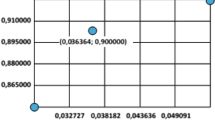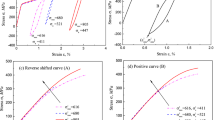Abstract
Rice (1966) considered a growing crack in an elastic-plastic material where the flow strength saturates, and demonstrated that there is no energy available for the propagation. This is the famous «Paradox of Rice». Kfouri and Miller (1976) confirmed this result using an elastic-plastic finite element solution for an linear strain hardening material. We show in this paper that the result of Kfouri and Miller is questionable.
Similar content being viewed by others
References
Brust F. W. and Majumdar B.S., Load History Effects on Creep Crack Growth. Eng. Frac. Mech. Vol. 49, N°6, 1994, pp. 809–837.
Bui H.D., Recent developments in fracture mechanics. In K. P. Herrmann and L.H. Larson(eds.). Fracture of non metallic Materials, pp. 21–32. Brussels 1987.
Kfouri A.P. and Miller K.J., Crack separation energy rate for crack advance in elastic-plastic fracture mechanics, Proc. Inst. Mech. Engrs. 190, 1976, pp. 571–584.
Kfouri A.P. and Rice J.R., Elastic/plastic separation energy rate for crack advance in finite growth steps, in Fracture 1977, D.M.R. Taplin, Vol. 1, Univ. Waterloo Press, pp. 43–59.
Lorentz E., Wadier Y., Debruyne G., Elastic-plastic Fracture Mechanics: definition of an energy release rate (in French). C. R. A. S. t 328, série IIb, 2000, pp. 657–662.
Lorentz E., Wadier Y., The energy approach of elastic-plastic fracture mechanics applied to the progressive or sudden propagation of a notch (in french), Giens 2003, France, Vol 1, pp. 389–396.
Moran B. and Shih C.F., Crack Tip and Associated Domain Integrals from Momentum and Energy Balance. Eng. Frac. Mech. Vol. 27, N°6, 1987, pp. 615–642.
Nguyen Q.S. Energies methods in Mechanics (in French). Journ. Meca. Vol 19, N°2, 1980, pp.363–386.
Rice J.R., An examination of the fracture mechanics energy balance from the point of view of continuum mechanics. Proc. 1st Int. Conf. Fracture, vol. 1, Sendai, Japan, ed. Yokobori et al., (1966), pp. 309–340.
Rice J.R. and Sorensen E.P., Continuing Crack Tip Deformation and Fracture for Plane Strain Crack Growth in Elastic-Plastic Solids. J. Mech. Phys. Solids, 26, 1978, pp. 163–186.
Rice J.R., The mechanics of quasi-static crack growth. Proc. 8th U.S. Nat. Congr. of Appl. Mech., ed. R.E. Kelly, (1978), pp. 191–215.
Wadier Y., Bonnamy M., Progr. VOCALIST: the energy approach of EPFM applied to the analysis of the shallow crack effect, ASME PVP, Cleveland-USA-2003, Vol 462, pp. 147–154.
Author information
Authors and Affiliations
Rights and permissions
About this article
Cite this article
Wadier, Y. Reconsidering the Paradox of Rice for a Linear Strain Hardening Material. International Journal of Fracture 127, L125–L132 (2004). https://doi.org/10.1023/B:FRAC.0000035086.75565.b3
Issue Date:
DOI: https://doi.org/10.1023/B:FRAC.0000035086.75565.b3




